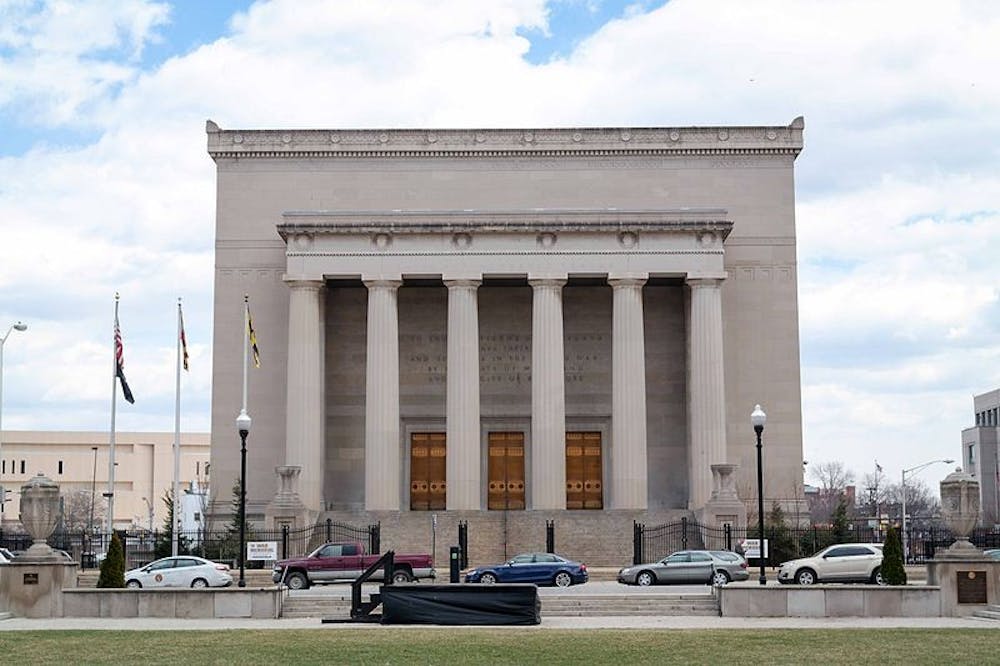In its first performance of the season, this past Sunday, Oct. 15., the Hopkins Symphony Orchestra (HSO) assembled at the Baltimore War Memorial.
While the HSO normally performs in Shriver Hall, recent construction has forced a move to the War Memorial, a stately monument located in the Inner Harbor.
Before the performance, audience members were invited to take a Baltimore Heritage tour of the historic building.
The main hall of the memorial, where the concert took place, was a grand rectangular space with high stone walls, lines of glowing chandeliers and a single flame burning on the back wall.
This setting was fitting for the bold, sweeping sound produced by the orchestra conducted by Jed Gaylin.
The orchestra itself consisted of a sizeable string section up front and a smaller wind section positioned on elevated stands in the back. Though there were only three string bass players, they still managed to create a full sound.
The first piece of the afternoon was Prelude and Quadruple Fugue, Op. 128. The piece, composed by the 20th century composer Alan Hovhaness, began with a slower, more rambling melody in the Prelude. As it transitioned to the Fugue, the tempo built and the brass section became more involved.
Max Derrickson, the writer of the program notes, described this part of the piece as a “tour-de-force.” The fullness of all the sections playing together echoed throughout the space, enveloping the audience in a cave of sound.
The next piece was the Violin Concerto in D Minor, Op. 47, composed by Jean Sibelius. According to Derrickson, among the concertos in Sibelius’ repertoire, this is one of the “most popular, most performed and most recorded.”
The violin solo was performed by Jonathan Carney, the Baltimore Symphony Orchestra (BSO) concertmaster. Carney is currently in his 16th season with the BSO and previously performed 12 seasons with London’s Royal Philharmonic Orchestra.
He also currently serves as artistic director for the Maryland Classic Youth Orchestra and is an artist in residence at the Baltimore School for the Arts.
His years of experience and passion for the instrument were on show that afternoon as he skillfully glided up and down the fingerboard between lower notes and harmonics, his entire body swaying with the melody.
The first movement began by featuring Carney, who stood in front of the conductor. He was accompanied by a pulsing string section which transitioned into a bolder sound as the piece developed.
The second movement added more sound from the rest of the strings but retained the more somber tone of the first.
As Derrickson noted, it takes almost four minutes for the “dark hues” to rise above the human speaking range.
Finally, the last movement brought a sudden shift in momentum. Each note was emphasized as the tempo grew faster and faster. Carney nimbly shifted between notes at incredible speeds until the final beat.
Several audience members leapt to their feet after the final note. This led to a standing ovation from almost the entire crowd that lasted minutes. It was by far the most lauded piece of the afternoon.
The final piece, Georges Bizet’s Symphony in C, was the longest and most dynamic. The first movement featured the oboe, which sounded like a bugle horn announcing the start of the piece.
After the introduction of the oboe and later the flute, the strings erupted in a bright melody that was matched by the deep calls of the brass and reeds.
Drawing a stark contrast from the first movement, the adagio movement was smooth and tranquil, evoking a calm running stream. The notes soon transitioned into a meandering snake-like pattern, with sparse plucking from the string section.
The last movement brought the concert to an energetic, joyful end. From start to finish, both the strings and the winds maintained a series of bouncing, fast-paced notes. Derrickson describes this element of the symphony as an, “‘off-to-races’ kind of finale.”
The HSO’s next performance will be Dec. 3 at the Memorial. The concert will include performances of Johannes Brahms’ Tragic Overture, Op. 81 and Variations on a Theme by Joseph Haydn.
It will also feature the mezzo-soprano Monica Reinagel and baritone Jason Buckwalter along with the JHU Choral Society and the Baltimore School for the Arts for Duruflé’s Requiem.





